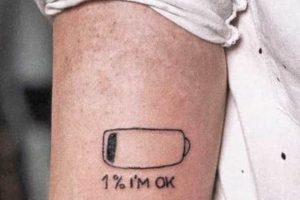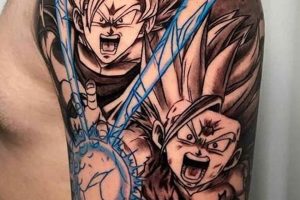Selecting the right location for body art is a crucial step in the tattooing process. This involves considering factors such as the size and design of the tattoo, the individual’s pain tolerance, and how the tattoo might change with body fluctuations. For example, a large, intricate design might be best suited for the back or thigh, while a small, symbolic tattoo could be placed on the wrist or ankle.
Careful consideration of location ensures the longevity and aesthetic appeal of the artwork. A well-placed tattoo complements the body’s natural contours and can enhance personal style. Historically, placement has held cultural and symbolic significance in various traditions, influencing the visibility and meaning of the designs. This thoughtful approach contributes to a more satisfying and meaningful experience.
Factors influencing these choices include aesthetics, practicality, and cultural significance. Exploring these elements provides a deeper understanding of the art form and empowers individuals to make informed decisions.
1. Visibility
Visibility plays a significant role in the decision-making process for body art placement. The degree to which a tattoo is visible influences its impact and personal meaning. Whether one seeks a prominent display or a more discreet location shapes the overall aesthetic and communicates different messages.
- Public Display
Tattoos placed on hands, necks, or faces are highly visible, making a bold statement. These locations often carry stronger social implications and may be subject to more scrutiny. Choosing these areas indicates a willingness to openly express oneself and embrace potential societal perceptions.
- Concealability
Placement on areas easily covered by clothing, such as the back, torso, or thighs, offers greater control over visibility. This allows individuals to choose when and where to display their body art, accommodating professional or social contexts that may require discretion. This option balances personal expression with practical considerations.
- Partial Visibility
Locations like the wrists, ankles, or forearms offer a balance between public display and concealability. These placements allow for glimpses of the tattoo, offering a subtle form of self-expression while maintaining the option for coverage. This approach can be particularly appealing for those seeking a less overt display.
- Personal Significance
The visibility of a tattoo can enhance its personal meaning. A discreet placement can hold deep significance for the individual, serving as a personal reminder or symbol. Conversely, a highly visible tattoo may be intended to share a message or commemorate a significant event, sparking conversations and connections.
Careful consideration of visibility ensures the chosen placement aligns with personal preferences and lifestyle. This factor contributes significantly to the overall impact and meaning of the tattoo, ensuring a result that resonates with the individual’s intentions and aesthetic vision.
2. Pain level
Pain tolerance is a critical factor in determining suitable placement. Areas with thin skin or close proximity to bone, such as ribs, ankles, feet, and elbows, tend to be more sensitive. Conversely, areas with more muscle or fat padding, like the thighs, outer arms, and back, generally offer a less painful experience. Understanding these variations empowers informed decision-making, enabling individuals to select locations that align with their comfort levels. For example, someone with a low pain tolerance might opt for a thigh tattoo, while someone with a higher tolerance might choose the ribs.
Pain levels also influence the duration and complexity of a tattoo session. Highly sensitive areas may require multiple shorter sessions to manage discomfort effectively. This necessitates open communication between the artist and the individual, allowing for breaks and adjustments as needed. Choosing a placement that aligns with pain tolerance contributes to a more positive and manageable experience, minimizing stress and ensuring the individual can fully engage with the artistic process. Ignoring pain tolerance can lead to premature termination of a session, resulting in an incomplete or compromised design.
Managing pain effectively is crucial for a successful outcome. Various techniques, such as topical numbing creams, controlled breathing exercises, and open communication with the artist, can help mitigate discomfort. Recognizing the relationship between placement and pain allows individuals to prepare mentally and physically for the procedure. Ultimately, considering pain tolerance as a key element in placement decisions contributes to a more comfortable, positive, and ultimately satisfying tattooing experience.
3. Body Changes
Body fluctuations over time significantly impact the appearance and longevity of tattoos. Weight gain or loss, muscle growth or atrophy, and pregnancy can stretch, distort, or fade the ink. Areas prone to significant changes, such as the abdomen, breasts, and upper arms, require careful consideration. For example, a tattoo placed on the abdomen may become significantly distorted during pregnancy. Choosing designs that accommodate potential changes, such as smaller pieces or patterns that integrate with the body’s natural contours, helps maintain the integrity of the artwork over time. Selecting stable locations, like the back or the outer thigh, minimizes the risk of distortion due to weight fluctuations.
Understanding how skin elasticity varies across different body parts is also crucial. Areas with naturally higher elasticity, like the inner thighs and upper arms, are more susceptible to stretching and require designs that adapt to these changes. Smaller, simpler designs or those that incorporate flexible lines and patterns are typically better suited for these areas. Larger, more intricate designs may be better placed on areas with less elasticity, such as the outer thighs or the back. Consulting with a tattoo artist experienced in placement strategies for various body types provides valuable insights and helps ensure a visually appealing result that ages well.
Planning for potential body changes is essential for maintaining the aesthetic integrity of a tattoo. This proactive approach minimizes the risk of distortion and ensures the artwork remains visually appealing over the long term. Factors like weight fluctuations, muscle growth, and pregnancy should be discussed with a tattoo artist to determine the most suitable placement and design choices. Choosing adaptable designs and stable locations, combined with an understanding of skin elasticity, contributes to a tattoo that retains its intended appearance and meaning throughout life’s transitions.
4. Design Suitability
Design suitability is paramount in maximizing the aesthetic impact and longevity of a tattoo. Harmonizing the design with the chosen body part ensures the artwork complements the individual’s form and retains its visual appeal over time. Careful consideration of size, style, and detail in relation to body contours is crucial for a successful outcome.
- Size and Scale
The size of a tattoo must be proportionate to the chosen placement. Large, intricate designs require ample space, making areas like the back, chest, or thighs suitable canvases. Smaller, minimalist designs are well-suited for wrists, ankles, or behind the ear. Disregarding scale can result in a cramped or underwhelming appearance. A large, detailed portrait, for instance, would be ill-suited for a finger, while a small, symbolic design might get lost on a vast expanse like the back.
- Style and Composition
Certain styles lend themselves better to specific body parts. Flowing, organic designs can accentuate the curves of the hips or shoulders. Geometric patterns can create striking visuals on flatter surfaces like the forearm or shin. A tribal band, for example, naturally conforms to the bicep, while a delicate floral piece might be more fitting for the collarbone. Careful consideration of style and composition ensures the design complements the body’s natural lines.
- Detail and Intricacy
Highly detailed designs require areas with sufficient space to prevent blurring or loss of intricacy over time. Areas prone to stretching or wrinkling, such as elbows and knees, may not be ideal for intricate pieces. A highly detailed mandala, for example, would be better suited for a flat surface like the upper back rather than a joint like the elbow. Simpler designs with bolder lines tend to age better in areas prone to movement and skin changes.
- Movement and Distortion
Placement on joints or areas with frequent movement necessitates designs that can withstand distortion. Flexible lines and patterns are better suited for these areas compared to rigid geometric shapes that may warp over time. A design intended for the wrist, for example, should consider the joint’s flexibility to prevent the image from distorting with hand movements. Choosing a design that complements the natural movement of the body part ensures the artwork remains visually appealing regardless of posture or activity.
Integrating these design elements with careful placement choices creates a harmonious and impactful result. The interplay between design and placement ensures the artwork enhances the individual’s form, effectively conveying the intended message or aesthetic, and maintaining its visual appeal over time. A well-considered design, thoughtfully placed, becomes an integral part of personal expression.
5. Cultural Significance
Placement choices are often deeply intertwined with cultural significance. In various traditions, specific locations hold symbolic meaning, influencing the design’s interpretation and social impact. Understanding these cultural nuances provides valuable context for informed decision-making, enriching the tattooing experience with a deeper appreciation for its historical and societal relevance.
- Polynesian Tattoos
In Polynesian cultures, placement traditionally reflects lineage, status, and spiritual beliefs. Facial tattoos, for example, often denote high rank or ancestry, while tattoos on the limbs might represent skills or accomplishments. The intricate patterns and specific locations combine to tell a visual story deeply rooted in cultural heritage.
- Japanese Irezumi
Japanese Irezumi, characterized by large-scale designs and vibrant colors, often incorporates symbolic imagery with specific placements. Dragons placed on the chest symbolize wisdom and strength, while koi fish ascending the body represent perseverance and overcoming adversity. These placements amplify the underlying meaning of the chosen motifs.
- Indigenous Tribal Tattoos
Many indigenous cultures utilize placement to communicate clan affiliation, spiritual beliefs, or life transitions. Tattoos on the face or hands might signify a coming-of-age ritual, while designs on the torso could represent connection to ancestors or spiritual guides. Placement enhances the communicative power of these traditional markings.
- Cultural Appropriation
It is essential to avoid appropriating culturally significant designs or placements without understanding their meaning. Placing a culturally specific symbol on a body part traditionally reserved for a specific meaning within that culture can be disrespectful and offensive. Thorough research and respectful engagement with the culture of origin are crucial before adopting such designs.
Considering cultural context elevates the tattooing process beyond mere aesthetics. By understanding the historical and societal implications of placement choices, individuals can make more informed decisions that honor traditions and deepen the personal meaning of their body art. This awareness fosters a more respectful and meaningful approach to tattooing, enriching the experience for both the individual and the broader community.
Tips for Choosing Tattoo Placements
Selecting appropriate body art placement involves careful consideration of several factors. The following tips offer guidance for making informed decisions that align with individual preferences and desired outcomes.
Tip 1: Research Thoroughly
Explore various placements, styles, and artists before committing to a design. Gathering inspiration and understanding different artistic approaches helps individuals make choices that resonate with their personal style and desired aesthetic.
Tip 2: Consult with a Professional Artist
Experienced tattoo artists offer valuable insights into design suitability, placement options, and pain management techniques. Their expertise ensures informed decisions and contributes to a positive and successful tattooing experience.
Tip 3: Consider Lifestyle and Profession
Visibility plays a crucial role in placement choices. Individuals should consider their professional and social environments when deciding on the location and design of their body art. Certain professions may require more discreet placements.
Tip 4: Plan for the Future
Body changes over time can impact the appearance of a tattoo. Choosing placements less prone to distortion due to weight fluctuations, muscle growth, or aging ensures the artwork retains its integrity over time.
Tip 5: Prioritize Pain Management
Understanding pain tolerance and selecting placements accordingly contributes to a more comfortable experience. Discussing pain management techniques with the artist helps mitigate discomfort during the procedure.
Tip 6: Respect Cultural Significance
Researching the cultural implications of chosen designs and placements demonstrates respect for traditions and avoids unintentional appropriation. This awareness enhances the meaning and significance of the body art.
Tip 7: Start Small and Simple
For first-time recipients, starting with a smaller, simpler design allows for an assessment of pain tolerance and the healing process. This approach provides valuable experience before committing to larger, more complex pieces.
Following these guidelines contributes to a positive and fulfilling tattooing experience, resulting in body art that holds personal meaning and aesthetic value for years to come.
By considering these factors, individuals can embark on the tattooing journey with confidence, ensuring a result that aligns with their vision and enhances their personal expression.
Frequently Asked Questions
Addressing common inquiries regarding body art placement provides clarity and empowers informed decisions. The following questions and answers offer valuable insights into this crucial aspect of the tattooing process.
Question 1: How does placement affect the longevity of a tattoo?
Areas prone to stretching or friction, such as joints and inner thighs, may experience faster ink fading or distortion. Stable areas like the back or outer thigh generally maintain tattoo integrity longer.
Question 2: What are the most and least painful locations?
Areas with thin skin or close proximity to bone (ribs, ankles, feet) tend to be more sensitive. Fleshier areas (thighs, outer arms, back) generally offer a less painful experience.
Question 3: Can body changes distort a tattoo?
Weight fluctuations, muscle growth, and pregnancy can distort tattoos. Placement on areas prone to change (abdomen, breasts) requires careful consideration. Choosing adaptable designs helps mitigate this risk.
Question 4: How does placement relate to cultural sensitivity?
Certain designs and placements hold specific meanings in different cultures. Researching cultural significance beforehand ensures respectful choices and avoids unintentional appropriation.
Question 5: What factors influence placement decisions for first-time recipients?
Pain tolerance, desired visibility, and lifestyle considerations are key factors for first-timers. Starting with smaller, simpler designs in less sensitive areas is often recommended.
Question 6: How important is consulting a tattoo artist regarding placement?
Consulting an experienced artist is crucial. Artists provide expert guidance on design suitability, optimal placement, pain management, and aftercare, ensuring a positive and successful outcome.
Careful consideration of these factors empowers individuals to make informed decisions, ensuring body art that aligns with personal preferences and stands the test of time.
Exploring these elements further provides a deeper understanding of the intricate relationship between body art and personal expression.
Conclusion
Careful selection of tattoo placement is paramount for achieving desired aesthetic outcomes and ensuring long-term satisfaction. Factors such as pain tolerance, body changes, design suitability, visibility, and cultural significance play crucial roles in this decision-making process. Understanding the interplay of these elements empowers informed choices that reflect personal style and enhance the meaning of body art.
Thoughtful consideration of placement elevates tattooing beyond mere aesthetics, transforming it into a powerful form of self-expression and storytelling. By integrating these considerations, individuals embark on a journey of personal expression, ensuring their body art remains a source of pride and meaning for years to come.







